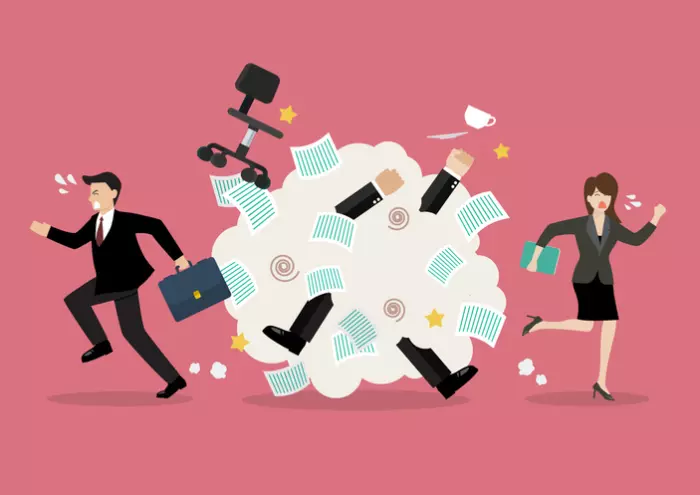I once worked for a large Wellington organisation where two male members of the communications team came to blows in the office. Actual physical, knock-someone’s-teeth-out blows.
I can’t recall what triggered the angry meltdown, or who said what, but I do recall the words “suspended” and “anger management courses” featured significantly in both their futures.
Sally Duxfield isn’t surprised. The peak-performance mentor and leadership consultant says workplace anger is more common than we think.
“At one point or another we’ve all felt angry at work – you pull an all-nighter on a project which is then scrapped, your boss criticises you for no valid reason, or your colleague pulls a sickie, leaving you to do the work,” she says. “Naturally, these aggressions can make your blood boil.”
US figures show that around 65% of office workers have experienced office rage, and 45% of staff regularly lose their tempers at work.
The reason for that? One Australian study revealed that the most common cause of workplace anger is being treated unjustly (77%). Researchers also found that we don’t cope so well with being the target of behaviour such as laziness or theft (23%), or being disrespected by our co-workers (20%).
Throw a two-year global pandemic into the mix and watch those tempers melt faster than an ice-cream on a January day.
 Leadership consultant Sally Duxfield. Photo: Supplied.
Leadership consultant Sally Duxfield. Photo: Supplied.
“Covid has given many of us the perception that we have no control over our days,” says Duxfield. So the smallest issue, something that a few years ago might not have bothered us, now sparks our fight-or-flight response and we become reactionary, not thinking clearly, blaming others and, often, beating ourselves up for getting upset.
“In this state, we’re prone to poor judgement and saying things we might later regret.
“When we have a sense of reduced control and rhythm in our days, the level of the stress hormones cortisol and noradrenaline in our system increases, while the level of serotonin, the satisfaction drug, decreases. In this situation, if someone pisses you off, you’re not in a good state to manage your response.”
While anger gets a bad rap, Duxfield believes it can also be a superpower that gives us strength and motivation.
“Stress, and its sister emotion, anger, can actually make us sharper, more driven and confident. We all need a sense of motivation to flip us into doing something.”
Which could be why during US Navy SEAL training, recruits are taught how to use the intense emotions and adrenaline that come from anger to give them energy when they face dangerous circumstances.
But Duxfield, who’s worked with everyone from the Junior All Blacks and military pilots to law firms and dairy farmers, says anger can also be the signal that something is wrong. “The key is to de-escalate the situation, focus quickly and harness the energy effectively to enable you to use that energy for a productive outcome.”
One example is Red2Blue, the technique pioneered by Kiwi psychiatrist and sports psychologist Ceri Evans to help the All Blacks win the 2011 and 2015 Rugby World Cups. The strategy, which has since been adopted by corporates, the military and elite sports teams around the globe, focuses on moving from anger and anxiety to a place of calm and accuracy.
“The red head is tight, inhibited and anxious, the fight-or-flight response, which is often accompanied by feelings of blame and uncertainty,” says Duxfield. “The blue head, on the other hand, is calm, clear and accurate and decreases stress. Getting from red to blue can be the difference between triumph and disaster.”
It’s a useful analogy for situations of workplace tension, she adds.
“What are the tools we need so that we can avoid the flight-or-fight response and make it to the blue side? The first step is to acknowledge that anger is a legitimate and normal emotion, one that’s deeply embedded in our evolutionary code because it’s how we fend off dangers and threats to our well-being. So trying to avoid anger doesn’t help. Instead, physically stepping back and centring yourself – breathing deeply and even rubbing your fingers together – can help to refocus or disarm your anger in a healthy way. Accepting your reaction, rather than fighting it, will calm you down and free you to focus on problem solving.”
Rhythm and routine are also key. In the high-performance leadership teams Duxfield works with, that looks like being more prescriptive with our day and carving out offline, deep-thinking times. “Just one of these 45- to 60-minute chunks a day can be sufficient to stave off feelings of overwhelm.”
Having a suitable response ready before anger arises also helps. “Words like, ‘I’d like to discuss this further, can I book a time?’ Write down a response, rote-learn it and use it in tense situations because that can take the heat out of the immediate situation and show you want to sort it out – but in a calmer way at a later time.”
Getting a facilitator in can also help colleagues to better understand each other, Duxfield says. “If you know and trust each other, that’s a huge step towards defusing tension.”
Learning your triggers is a biggie, because understanding who and what makes you angry is key to heading off a meltdown. “For example, my staff know when I’m getting fired up and my operations manager will say, ‘Go away and take that attitude with you!’ It’s about paying attention to the circumstances and people who make you angry so you can better anticipate and manage your reactions in the future.
“If, for example, one particular colleague pushes your buttons, build in breaks during times when you know you have to work together. This will give you space to disrupt any rising anger that might pop up if he or she provokes you, which can help to avoid a hair-trigger reaction.”
They’re all strategies that Duxfield believes could be on high rotation over the next year or so as staff return to the office following the pandemic-induced period of working from home.
“Some people have fallen out of the habit of working with others in the office, so coming together again after a long period can cause stress and anger to spike. The introverts will say, ‘I hate this, I want to go home’, while the peacocks, the extroverts, will be joyful. I’m predicting there will be a spike in office anger over the next 12 months as people find their rhythm of working together again.’’













